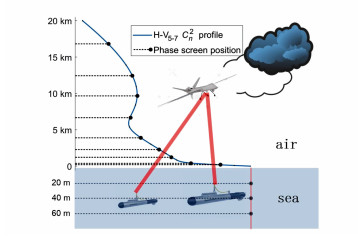| [1] |
MAKAVITA C D, JAYASINGHE S G, NGUYEN H D, et al.. Experimental study of command governor adaptive control for unmanned underwater vehicles[J]. IEEE Transactions on Control Systems Technology, 2019, 27(1):332-345. doi: 10.1109/TCST.2017.2757021
|
| [2] |
SEDAGHATI S, ABDOLLAHI F, KHORASANI K. Model predictive and non-cooperative dynamic game fault recovery control strategies for a network of unmanned underwater vehicles[J]. International Journal of Control, 2017, doi: 10.1080/00207179.2017.1360517.
|
| [3] |
PREISIG J. Acoustic propagation considerations for underwater acoustic communications network development[C]. ACM International Workshop on Underwater Networks, ACM, 2006: 1-5.
|
| [4] |
CHITRE M, POTTER J, HENG O S. Underwater acoustic channel characterisation for medium-range shallow water communications[C]. Oceans '04. MTS/IEEE Techno-Ocean, IEEE, 2004: 40-45.
|
| [5] |
RATNI B, DE LUSTRAC A, PIAU G P, et al.. Reconfigurable meta-mirror for wavefronts control: applications to microwave antennas[J]. Optics Express, 2018, 26(3):2613-2624. doi: 10.1364/OE.26.002613
|
| [6] |
ZHANG D, HAO SH Q, ZHAO Q S, et al.. Wavefront reconstruction method based on wavelet fractal interpolation for coherent free space optical communication[J]. Optics Communications, 2018, 410:723-729. doi: 10.1016/j.optcom.2017.11.021
|
| [7] |
ELAMASSIE M, UYSAL M, BAYKAL Y, et al.. Effect of eddy diffusivity ratio on underwater optical scintillation index[J]. Journal of the Optical Society of America A, 2017, 34(11):1969-1973. doi: 10.1364/JOSAA.34.001969
|
| [8] |
BORAH D K, VOELZ D G. Spatially partially coherent beam parameter optimization for free space optical communications[J]. Optics Express, 2010, 18(20):20746-20758. doi: 10.1364/OE.18.020746
|
| [9] |
WANG M H, YUAN X H, MA D L. Potentials of radial partially coherent beams in free-space optical communication: a numerical investigation[J]. Applied Optics, 2017, 56(10):2851-2857. doi: 10.1364/AO.56.002851
|
| [10] |
ZHU X M, KAHN J M. Free-space optical communication through atmospheric turbulence channels[J]. IEEE Transactions on Communications, 2002, 50(8):1293-1300. doi: 10.1109/TCOMM.2002.800829
|
| [11] |
GERÇEKCIOǦLU H, BAYKAL Y, NAKIBOǦLU C. Annular beam scintillations in strong turbulence[J]. Journal of the Optical Society of America A, 2010, 27(8):1834-1839. doi: 10.1364/JOSAA.27.001834
|
| [12] |
JI X L, CHEN H, JI G M. Characteristics of annular beams propagating through atmospheric turbulence along a downlink path and an uplink path[J]. Applied Physics B, 2016, 122(8):221. doi: 10.1007/s00340-016-6491-z
|
| [13] |
EYYUBOǦLU H T, ALTAY S, BAYKAL Y. Propagation characteristics of higher-order annular Gaussian beams in atmospheric turbulence[J]. Optics Communications, 2006, 264(1):25-34. doi: 10.1016/j.optcom.2006.02.030
|
| [14] |
LI X Q, JI X L. Propagation characteristics of decentered annular beams through non-Kolmogorov turbulence[J]. Journal of the Optical Society of America A, 2014, 31(1):172-182. doi: 10.1364/JOSAA.31.000172
|
| [15] |
CYWIAK M, CYWIAK D, YÁÑEZ E. Finite Gaussian wavelet superposition and Fresnel diffraction integral for calculating the propagation of truncated, non-diffracting and accelerating beams[J]. Optics Communications, 2017, 405:132-142. doi: 10.1016/j.optcom.2017.08.015
|
| [16] |
FESHCHENKO R M, VINOGRADOV A V, ARTYUKOV I A. Propagation of waves from an arbitrary shaped surface-a generalization of the Fresnel diffraction integral[J]. Optics Communications, 2018, 413:291-294. doi: 10.1016/j.optcom.2017.12.070
|
| [17] |
DWIVEDI G, SHARMA A, DEBNATH S, et al.. Comparison of numerical reconstruction of digital holograms using angular spectrum method and Fresnel diffraction method[J]. Journal of Optics, 2017, doi: 10.1007/s12596-017-0424-z.
|
| [18] |
CHEN SH G, ZHANG T L, HU L B, et al.. Vertical variations in optical properties of the waters in the Yellow Sea and Bohai Sea at seasonal scales and their influencing mechanisms[J]. Optics Express, 2018, 26(4):4112-4134. doi: 10.1364/OE.26.004112
|
| [19] |
NIKISHOV V V, NIKISHOV V I. Spectrum of turbulent fluctuations of the sea-water refraction index[J]. International Journal of Fluid Mechanics Research, 2000, 27(1):82-98. doi: 10.1615/InterJFluidMechRes.v27.i1
|
| [20] |
SCHMIDT J D. Numerical simulation of optical wave propagation with examples in MATLAB[J]. Proceedings of SPIE, 2010, PM199:212. https://www.researchgate.net/publication/303725548_Numerical_simulation_of_optical_wave_propagation_With_examples_in_MATLAB
|
| [21] |
ANDREWS L C, PHILIPS R L. Laser Beam Propagation Through Random Media[M]. 2nd ed. Bellingham, WA:SPIE, 2005.
|






 下载:
下载:







